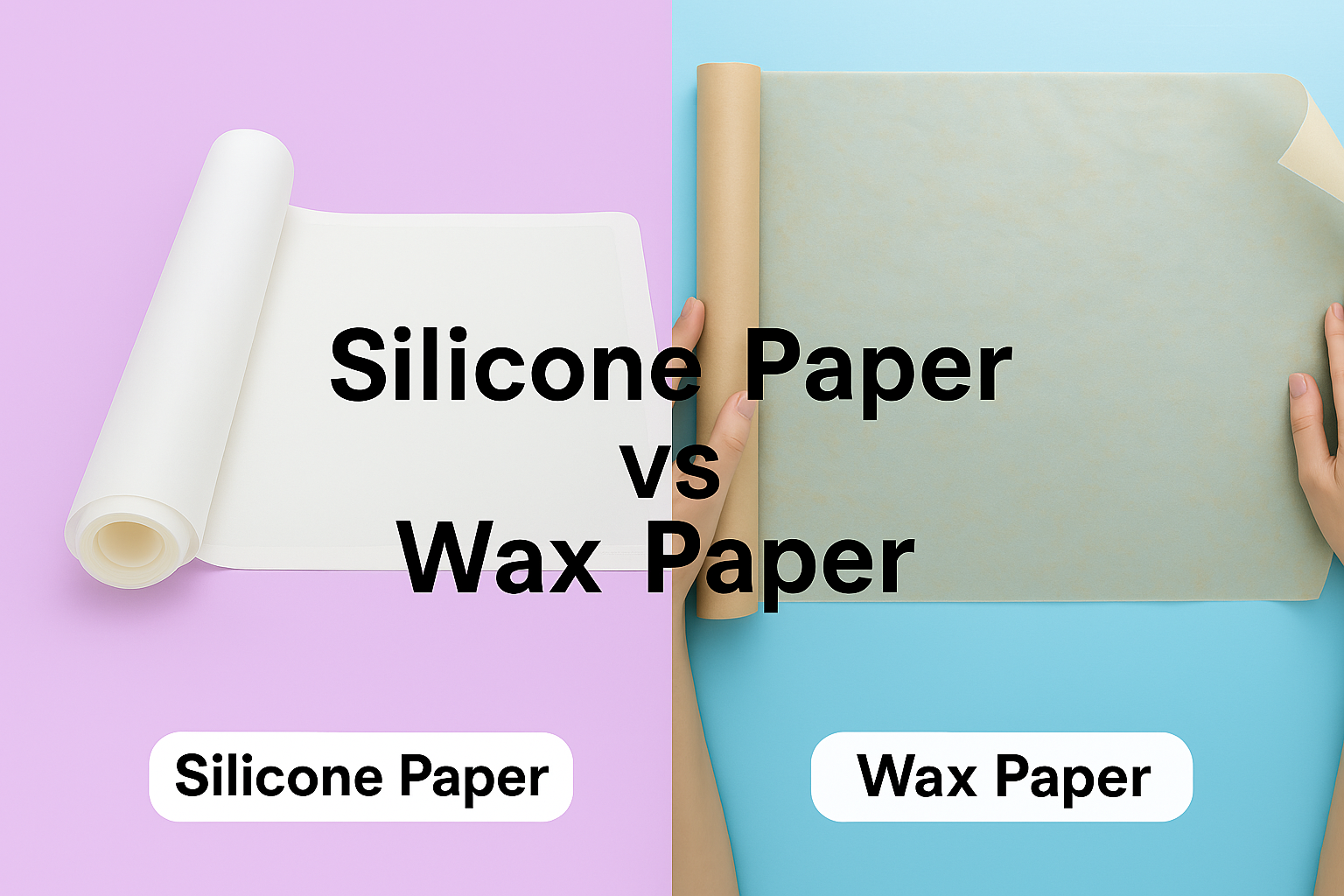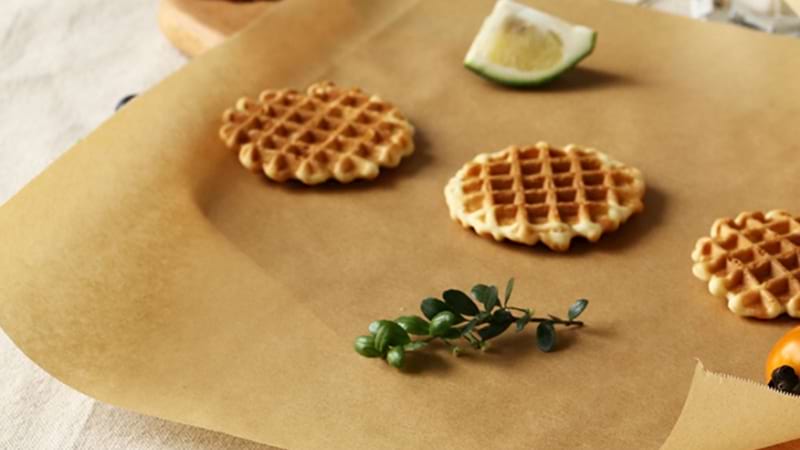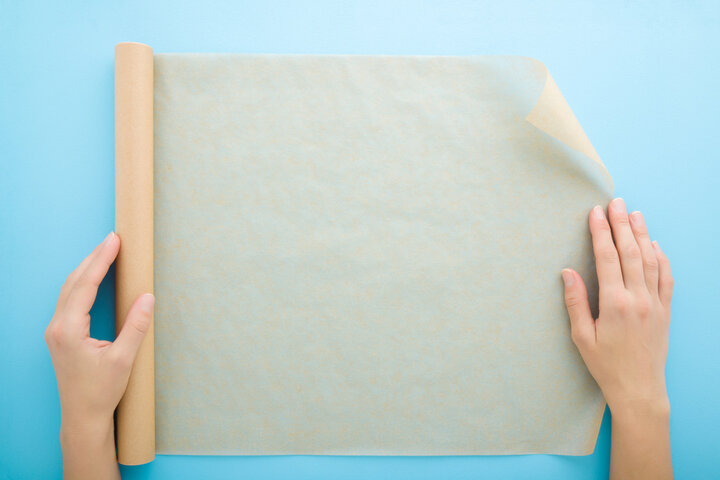
Silicone paper and wax paper may look similar, but they serve very different purposes in the kitchen. Whether you're baking, wrapping food, or storing leftovers, choosing the right one can save you time, effort, and even your recipe.
In this post, we’ll explore the key differences between silicone paper and wax paper, from heat resistance and non-stick performance to reusability and best-use scenarios. If you’ve ever been unsure which to grab, this guide will help you make the right choice with confidence.
What is Silicone Paper?
What It's Made Of
Silicone paper starts as regular paper but gets coated with a thin layer of silicone. That layer gives it unique qualities—it won’t absorb grease or moisture, and it can handle heat. People often confuse it with parchment paper, but the silicone layer makes it stronger and more heat-tolerant.

Why It Stands Out
Heat-Resistant: It holds up well in ovens—usually up to 220°C (428°F) or even higher—without burning or curling.
Greaseproof Surface: Oils and fats won’t soak through, making it perfect for high-fat recipes.
Reusable: Unlike many papers, it can be wiped clean and reused a few times before discarding.
How People Use It
1. For Baking and Roasting
It’s great for lining trays or pans when baking cookies, pastries, or roasting vegetables. You won’t need extra oil or cooking spray, and food slides right off.
2. For Working with Sticky Foods
Use it as a surface for rolling sticky dough, kneading pastry, or melting chocolate. The silicone layer prevents things from sticking without needing flour or extra grease.
3. For Wrapping Oily or Sticky Items
Silicone paper is often used to wrap greasy or gooey foods—like soft cheeses, butter-based pastries, or homemade candies. It holds its shape and keeps your hands (and fridge) mess-free.
Quick Look: Silicone Paper at a Glance
| Feature | Description |
| Heat Safe? | Yes, usually up to 220°C (428°F) or more |
| Grease/Moisture Proof | Excellent resistance, no soaking or tearing |
| Reusability | Can be reused 2–3 times depending on the usage |
| Common Uses | Baking, roasting, rolling dough, food wrapping |
What is Wax Paper?
What It's Made From
Wax paper is made by coating regular paper with a layer of wax—usually paraffin or sometimes soybean-based. This wax creates a smooth, slightly glossy surface. It’s moisture-resistant but not designed to handle high temperatures. If heated, the wax melts or burns, so it’s not safe for ovens or toasters.

Key Qualities
Water Barrier: The wax coating keeps moisture in or out, making it useful for food that needs to stay dry or fresh.
Low Heat Tolerance: It can't handle oven use. The wax will melt, smoke, or catch fire if it gets too hot.
How Wax Paper Is Used
1. For Wrapping Cold Foods
It’s a favorite for wrapping sandwiches, cheese slices, and deli cuts. The waxy surface keeps food fresh longer and prevents sticking or leaking. It’s also easy to fold and shape around food.
2. As a Work Surface
During food prep, it can line countertops to catch crumbs, sauces, or dough. That makes cleanup easier—just toss it out after. It’s helpful when coating things in flour or separating wet ingredients.
3. For Freezing or Storing
Wax paper works well for layering or separating sticky items before freezing, like burger patties, cookie dough, or pastries. The wax stops them from clumping together in storage.
Quick Look: Wax Paper at a Glance
| Feature | Description |
| Heat Safe? | No—melts or burns under high heat |
| Moisture Resistance | Good for short-term protection against moisture |
| Reusability | Single-use only, usually discarded after one use |
| Common Uses | Wrapping sandwiches, food prep, freezing |
Silicone Paper vs Wax Paper: Side-by-Side Comparison
Heat Resistance
Silicone paper: Withstands high temperatures, making it safe for use in ovens, microwaves, and under heat lamps without burning or smoking.
Wax paper: Not heat-resistant; it melts, smokes, or even catches fire when exposed to high temperatures. Suitable only for cold tasks.
Non-Stick Properties
Silicone paper: Provides a slick, food-safe surface that prevents sticking, perfect for sticky foods like cheese or dough, ensuring a mess-free experience.
Wax paper: Reduces sticking with dry foods but may leave wax residue under pressure or heat, especially when warm.
Strength and Durability
Silicone paper: Tear-resistant and durable even when wet, greasy, or loaded with heavy ingredients, making it ideal for layered or greasy baking tasks.
Wax paper: Thin and more prone to tearing when wet or under stress, suitable only for lighter tasks without excessive moisture or pressure.
Moisture and Grease Resistance
Silicone paper: Excellent resistance to moisture and grease, making it perfect for fatty or oily foods like bacon and pastries, keeping trays clean.
Wax paper: Provides basic moisture resistance but can degrade over time, with grease seeping through under warm or wet conditions.
Reusability and Cost-Effectiveness
Silicone paper: Can be reused multiple times, offering long-term savings, especially for frequent bakers.
Wax paper: Single-use only, requiring more sheets over time, making it less cost-effective for regular use despite the lower initial cost.
Can You Substitute Silicone Paper for Wax Paper?
Safe Situations for Substitution
Baking and Roasting: Silicone paper works well in the oven for baking, roasting, or preparing sticky foods like pastries and cheese. Its high heat resistance makes it a safe alternative to wax paper in these situations.
Hot or Greasy Foods: If you're dealing with greasy items like bacon or roasted vegetables, silicone paper can handle the oil and moisture without breaking down, unlike wax paper. It’s perfect for jobs where grease or heat is involved.
When You Shouldn't Substitute
Cold Wrapping: Silicone paper isn’t as flexible as wax paper, so it may not be ideal for wrapping delicate cold foods or for storing items that require more pliability, such as sandwiches.
Oven Applications: Wax paper should never be used in the oven. It can catch fire or melt when exposed to high temperatures. Silicone paper is the safer option for oven-based tasks.

Which One is Better for Baking?
Baking Sheets and Pans
Silicone Paper: Silicone paper promotes even browning of baked goods by distributing heat uniformly. It also allows for easy release of cookies, pastries, and other baked items, preventing sticking and ensuring they come off cleanly without any mess.
Wax Paper: Wax paper is not suitable for baking in the oven. When exposed to high heat, it can melt, smoke, or even catch fire. This makes it unsafe to use for baking or roasting, especially at temperatures above 200°F (93°C).
Pastry and Dough Handling
Silicone Paper: Silicone paper provides a smooth, slick surface that helps in rolling, shaping, and cutting dough. Whether you're working with sticky pastry dough or pizza crusts, it ensures everything stays in place and makes the process much easier without sticking.
Wax Paper: Wax paper doesn’t perform as well with moist doughs. The wax can soften and stick to the dough, tearing when you try to lift or move it. This can lead to frustration when rolling out delicate pastry or dough.
Which One is Better for Food Wrapping and Storage?
Cold Food Storage
Wax Paper: Wax paper is commonly used to wrap cold foods like sandwiches, cheese, and deli meats. Its flexible nature allows it to easily mold around food, keeping it fresh and ready to serve without creating any mess.
Silicone Paper: While silicone paper is moisture-resistant, it is stiffer compared to wax paper. It works well for wrapping food but may not provide the same flexibility needed to neatly wrap soft or delicate items like sandwiches.
Freezer Use
Silicone Paper: Silicone paper performs well in the freezer. It remains flexible even at low temperatures, preventing brittleness and cracks, which makes it ideal for wrapping frozen items without breaking down.
Wax Paper: Wax paper can also be used in the freezer but may become brittle over time. As it hardens, it may crack or tear when unwrapped, making it less reliable for long-term storage in cold conditions.
Professional and Home Use Cases
Ideal Use in Commercial Kitchens
Silicone Paper: Commercial kitchens often prefer silicone paper for its durability and heat resistance. It's ideal for repeated baking tasks, like cookies and pastries, as it can withstand high temperatures and multiple uses, making it more cost-effective over time.
Wax Paper: In high-volume settings, wax paper is commonly used for quick food wrapping or cold packaging. It’s ideal for wrapping sandwiches, deli meats, or baked goods for short-term storage, offering efficiency and ease of use in a fast-paced environment.
Best for Home Bakers
Silicone Paper: For home bakers, silicone paper offers versatility and durability. It’s perfect for repeated baking tasks like cookies, cakes, and pastries since it holds up well under heat and can be reused multiple times, making it more practical for regular baking.
Wax Paper: Wax paper is often the go-to for budget-conscious home bakers. It's ideal for wrapping food, storing sandwiches, or lining surfaces for easy cleanup. Though it’s single-use, it’s still an affordable option for occasional food storage and packaging.
Alternatives to Silicone and Wax Paper
Parchment Paper
Heat-Safe and Disposable
Parchment paper is heat-resistant and often mistaken for silicone paper. It’s great for one-time uses, like lining baking sheets or pans for cookies, cakes, or roasting. Its disposable nature makes cleaning up easy, but it can’t be reused, so it’s less durable than silicone alternatives for repeated baking tasks.
Best for Occasional Baking
Ideal for home bakers who don’t bake frequently, parchment paper provides convenience for occasional use. It’s great for lining pans and preventing food from sticking. However, it doesn’t have the longevity or reusability of silicone paper, so it's better suited for one-off baking tasks rather than daily use.
Aluminum Foil
Excellent Heat Resistance
Aluminum foil is known for its superior heat resistance, making it perfect for high-temperature cooking. It’s great for tasks like grilling, roasting, or wrapping foods for the oven. It reflects heat, ensuring even cooking, but lacks non-stick properties, so food may stick if not greased.
Not Suitable for Moist Foods
While aluminum foil works well for dry foods or greasy items, it's not ideal for moist or delicate foods. It can absorb moisture, leading to sogginess, and can stick to foods when used for wrapping or baking. This makes it less reliable for items like fish or wet dough.
Baking Mats (e.g., Silpat)
Reusable Silicone Surface
Baking mats, such as Silpat, are made from silicone and provide a reusable, non-stick surface for baking. They can handle high heat, making them perfect for cookies, pastries, and other baked goods. Unlike parchment paper or foil, these mats can be washed and reused for many baking sessions.
Ideal for Frequent Bakers
For frequent bakers, investing in a baking mat is cost-effective. These mats save money in the long run, as they eliminate the need for disposable paper and provide a consistent, reliable surface. They’re also environmentally friendly, making them an excellent alternative for those who bake often.

Final Comparison Table
| Feature | Silicone Paper | Wax Paper |
| Heat Resistance | ✅ Oven-safe | ❌ Not safe for oven |
| Non-Stick Surface | ✅ Excellent | ✅ Moderate |
| Grease/Moisture Proof | ✅ High resistance | ✅ Basic resistance |
| Reusability | ✅ Yes, often reusable | ❌ Single-use only |
| Strength | ✅ Tear-resistant | ❌ Prone to tearing |
| Best Use | Baking, sticky food prep | Food wrapping, cold storage |
Conclusion
Silicone paper is highly heat-resistant, durable, and reusable, making it a top choice for baking and handling sticky foods. Wax paper, on the other hand, is more affordable and convenient for cold food storage or wrapping, though it's not heat-safe and is single-use. Your decision should depend on your specific needs.
If you bake frequently, silicone paper is your best option for consistent results, as it handles heat and greasiness well. For quick food wrapping or low-cost, short-term storage, wax paper is a great, budget-friendly choice. Choose based on your kitchen tasks and preferences.
FAQs About Silicone Paper and Wax Paper
Can I use wax paper in the oven?
No, wax paper is not safe for oven use. It can melt, smoke, or even catch fire when exposed to heat.
Is silicone paper the same as parchment paper?
No, they’re different. Silicone paper is coated for non-stick use, while parchment paper is heat-resistant but lacks the same non-stick properties.
Which one is better for baking cookies?
Silicone paper is better for baking cookies. It provides a non-stick surface, ensuring easy release and even baking without sticking.
Can I use silicone paper to wrap sandwiches?
Yes, silicone paper works well for wrapping sandwiches. It’s moisture-resistant and keeps food fresh, though it’s stiffer than wax paper.






















